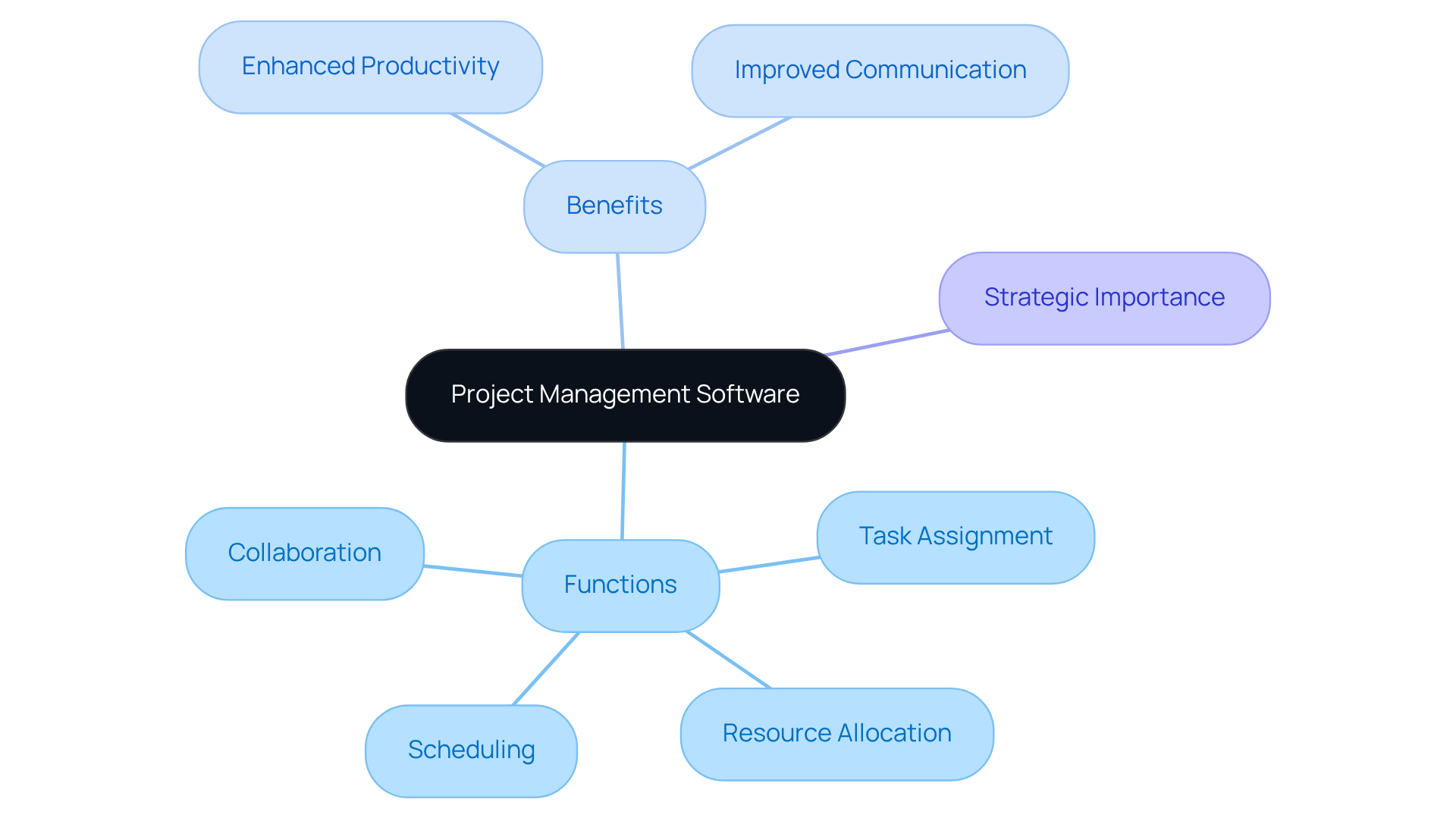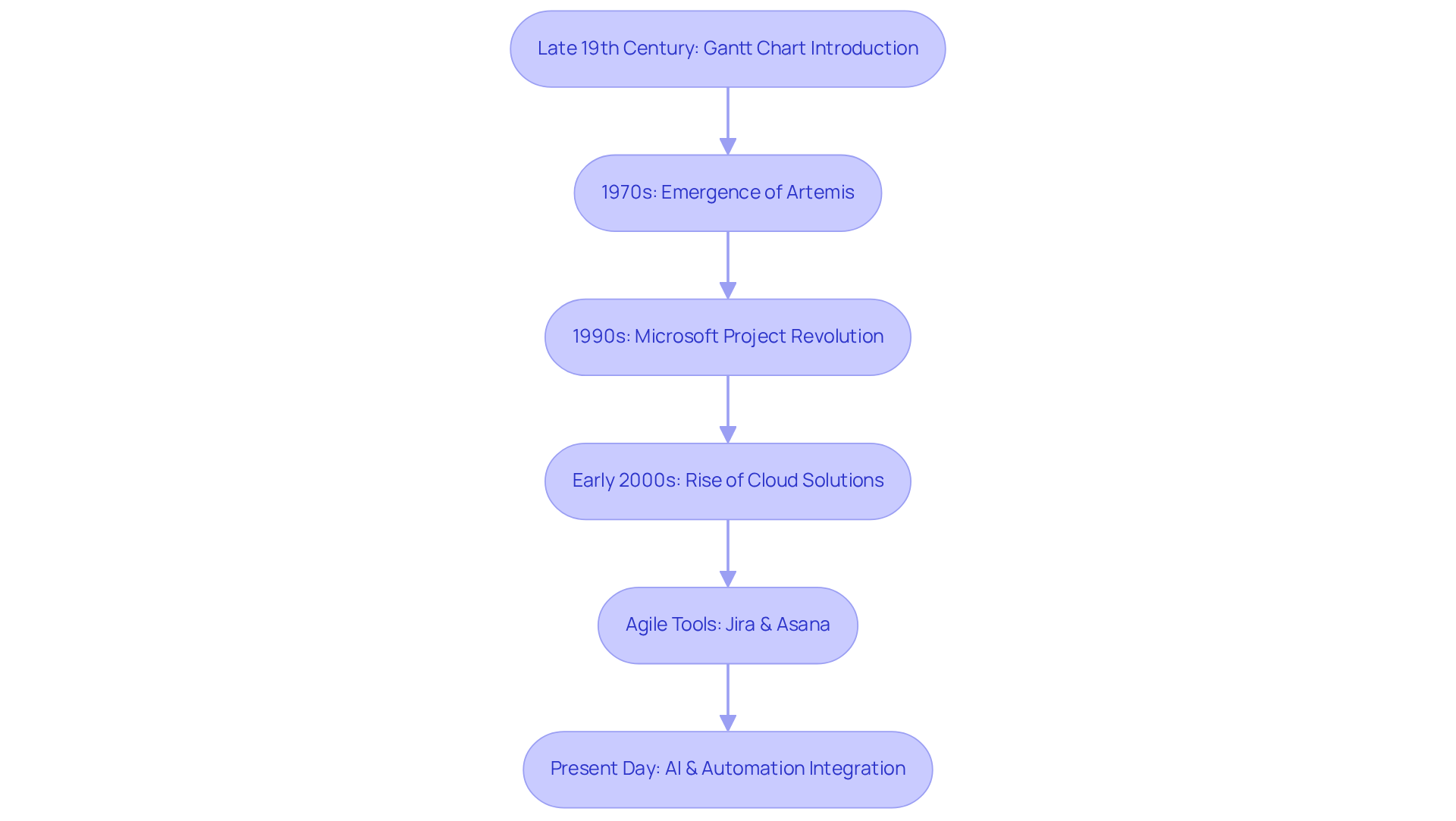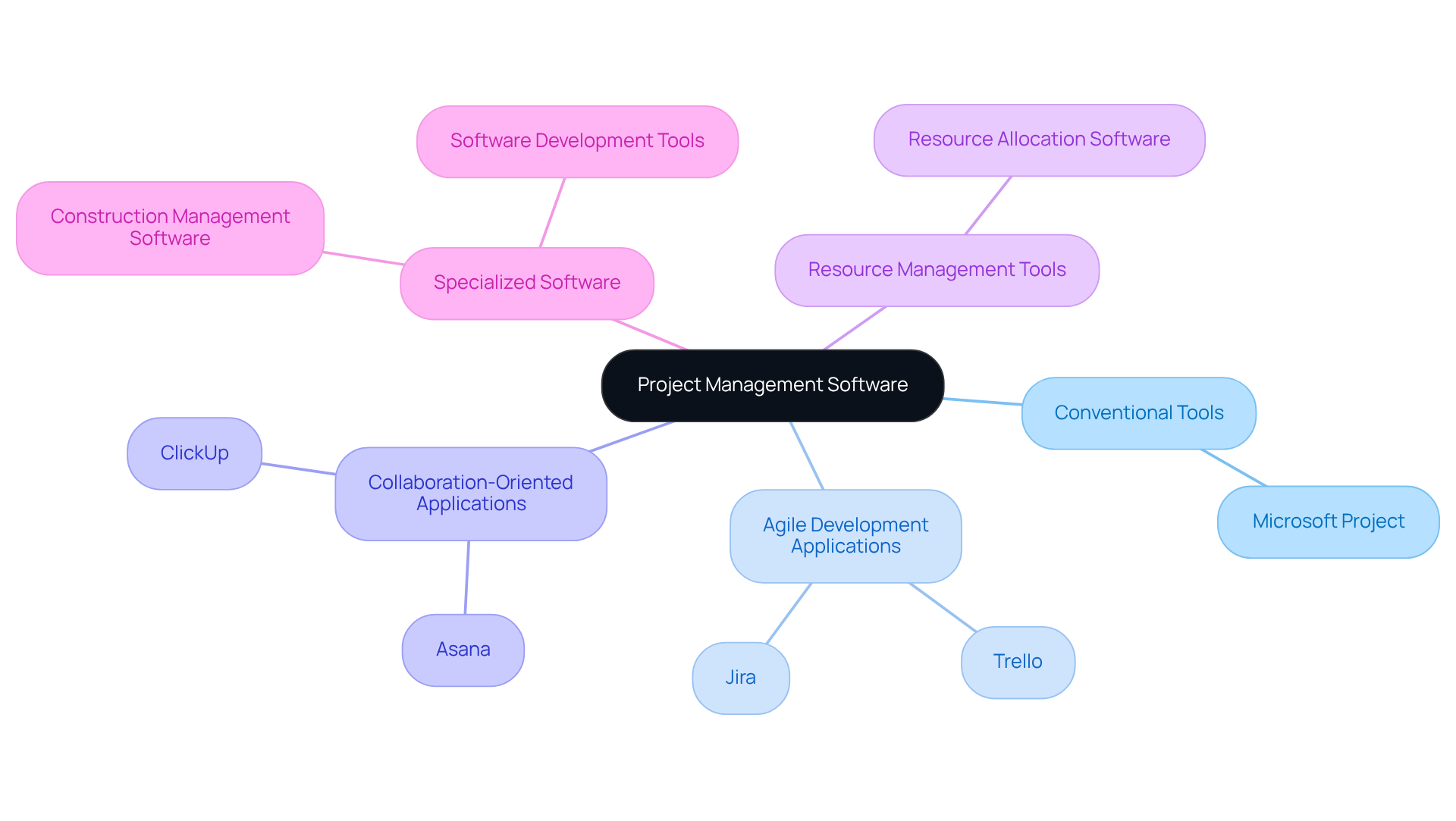Overview
Project management software represents a comprehensive suite of digital tools meticulously crafted to aid individuals and teams in organizing, executing, and overseeing projects with exceptional efficiency. This software encompasses vital features such as task assignment, resource allocation, and collaboration.
The article meticulously chronicles the evolution of these tools, tracing their journey from the rudimentary Gantt charts to sophisticated modern cloud-based solutions. Key features, including time tracking and reporting, are highlighted, underscoring their role in enhancing project management effectiveness within today’s intricate work environment.
This transformation not only reflects technological advancement but also addresses the growing complexities faced by project managers.
Introduction
Project management software has become an indispensable tool for teams striving to enhance productivity and streamline workflows. These digital solutions not only facilitate task organization and resource allocation but also foster collaboration, ensuring that every project is executed with precision.
As the landscape of project management evolves, marked by advancements such as cloud-based solutions and AI integration, one must consider: how can teams effectively navigate this ever-changing environment to maximize their success?
Define Project Management Software
To understand what is project management software, one must recognize that it represents a vital suite of digital resources designed to empower individuals and teams in organizing, executing, and overseeing initiatives with precision. These essential tools facilitate task assignment, resource allocation, scheduling, and collaboration, ensuring that all project-related activities are not only organized but also streamlined for efficiency. By providing a centralized platform for communication and documentation, task coordination tools enable teams to maintain clarity and focus. This ultimately fosters success in their endeavors.
Consider this: How often do teams struggle with disorganization and miscommunication? Project coordination applications address these challenges head-on, equipping teams with the capabilities to enhance productivity and achieve their objectives. With the right tools, project managers can ensure that every aspect of their projects is meticulously planned and executed. This level of organization is not just beneficial; it is essential for thriving in today’s competitive landscape.
In conclusion, embracing project coordination applications is a strategic move for any team aiming for success. By leveraging these tools, organizations can transform their project management processes, which demonstrates what is project management software, leading to improved outcomes and a more cohesive work environment.

Trace the Evolution of Project Management Software
The development of organizational tools for tasks has its roots in the late 19th century, marked by the introduction of the Gantt chart, a pioneering creation by Henry Gantt. This tool laid the groundwork for visual tracking and planning, revolutionizing how tasks were managed. Fast forward to the 1970s, and we see the emergence of specialized software aimed at task oversight, with Artemis by Metier Management Systems standing out as one of the first solutions crafted specifically for this purpose. The 1990s heralded significant advancements, particularly with the advent of Microsoft Project, which redefined planning and resource coordination capabilities.
As we entered the early 2000s, a pivotal shift occurred with the rise of the internet, facilitating the transition to cloud-based management solutions. This innovation not only enabled real-time collaboration but also transformed team interactions and task organization. With the increasing adoption of Agile methodologies, tools such as Jira and Asana surged in popularity, offering flexibility and robust support for iterative processes.
Today, we are witnessing the integration of artificial intelligence and automation features, marking the latest evolution in what is project management software. These advancements are not merely enhancements; they significantly boost efficiency by automating routine tasks, refining decision-making processes, and allowing managers to focus on strategic leadership. The continuous evolution of these resources reflects the growing complexity of tasks across various sectors, underscoring the importance of flexibility and creativity in this domain.

Identify Key Features of Project Management Software
To understand what is project management software, it is essential to recognize that it encompasses critical features such as:
- Task organization
- Collaboration resources
- Time monitoring
- Reporting functions for overseeing activities
How effectively are you managing your tasks? Task management empowers users to create, assign, and prioritize tasks, ensuring clarity in responsibilities. Meanwhile, collaboration tools enhance communication among team members through shared documents and messaging, fostering a cohesive work environment.
Time tracking features play a vital role in monitoring timelines and resource distribution. Are your tasks remaining on schedule? These tools help ensure that projects stay on track, promoting efficiency. Additionally, reporting capabilities provide valuable insights into project progress and performance metrics, enabling teams to make informed decisions swiftly.
To further enhance functionality, consider significant features like:
- Gantt charts
- Kanban boards
- Integration options with additional tools
These elements not only streamline processes but also enhance what is project management software. With the right software, you can transform the way your team collaborates and executes tasks, driving your startup towards success.

Explore Different Types of Project Management Software
Various types of project administration tools can be categorized based on their functionalities and methodologies, which explains what is project management software. Conventional tools for managing tasks, such as Microsoft Project, emphasize sequential planning and execution. In contrast, Agile development applications like Jira and Trello facilitate iterative progress and adaptability, making them ideal for teams that must adjust to evolving needs. Collaboration-oriented applications, including Asana and ClickUp, prioritize teamwork and communication, while resource management tools assist in efficiently allocating and tracking resources. Furthermore, specialized software that answers the question of what is project management software exists for industries such as construction and software development, catering specifically to unique project needs and workflows.

Conclusion
Project management software is an indispensable toolkit for organizing, executing, and overseeing projects with heightened efficiency. By streamlining communication, task assignment, and resource allocation, these digital solutions empower teams to successfully navigate complex projects. The central message underscores that adopting project management software is not merely advantageous; it is essential for achieving organizational goals in a competitive landscape.
The article traces the evolution of project management software from foundational tools like the Gantt chart to the sophisticated, cloud-based solutions available today. Key features such as:
- Task organization
- Collaboration resources
- Time tracking
- Reporting functions
are highlighted as vital components that enhance productivity. Furthermore, various types of project management tools are explored, demonstrating how they cater to different methodologies and industries, ensuring that teams can find the right fit for their unique needs.
Reflecting on the significance of project management software reveals that these tools transcend mere applications; they represent a strategic investment in a team's success. As organizations adapt to changing demands and complexities, leveraging the right project management software will not only improve outcomes but also foster a more collaborative and efficient work environment. Embracing advancements in project management is crucial for any team aiming to thrive and innovate in their respective fields.
Frequently Asked Questions
What is project management software?
Project management software is a suite of digital resources designed to help individuals and teams organize, execute, and oversee projects efficiently. It includes tools for task assignment, resource allocation, scheduling, and collaboration.
How does project management software improve team organization?
It provides a centralized platform for communication and documentation, which helps teams maintain clarity and focus, thereby enhancing productivity and reducing disorganization.
What challenges do project coordination applications address?
They address challenges such as disorganization and miscommunication within teams, equipping them with tools to enhance productivity and achieve their objectives.
Why is project management software essential for teams?
It is essential because it allows for meticulous planning and execution of every aspect of projects, which is crucial for success in today’s competitive landscape.
What benefits can organizations expect from using project management software?
Organizations can expect improved project management processes, better outcomes, and a more cohesive work environment by leveraging these tools.




